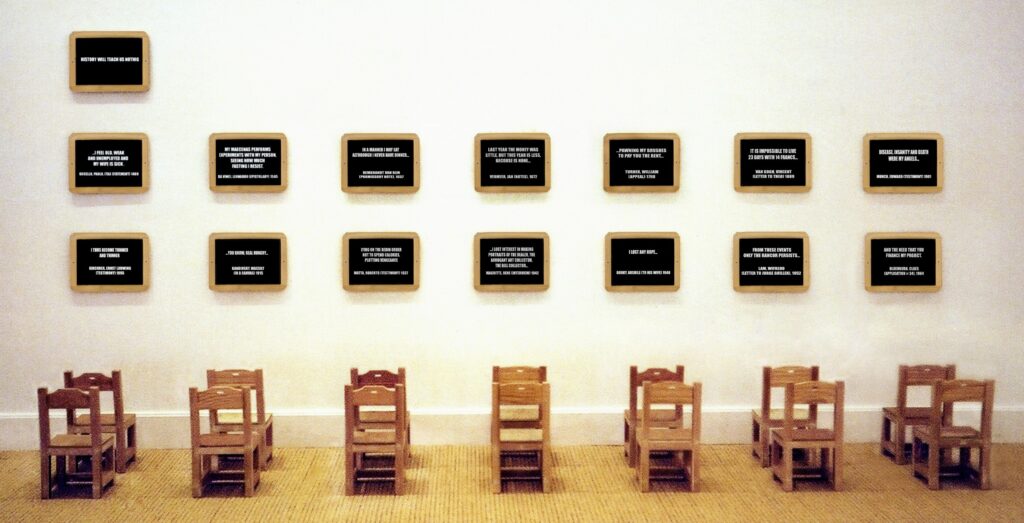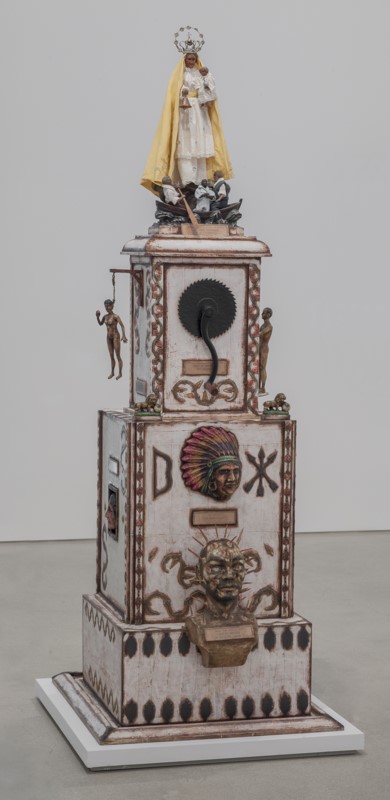
Rubén Torres Llorca. History Will Teach Us Nothing, 1998. Mixed media. Collection Pérez Art Museum Miami, promised gift of Craig and Ivelin Robins
Walking into the small, neat studio where Rubén Torres Llorca (b. 1957, Havana; lives in Miami) works, you are met at every turn with paintings and sculptures in various stages of completion. However, the object that dominates the room is a massive stereo with multiple turntables and speakers at human scale. A sculpture as much as a utilitarian object, it is built with parts that seem to emerge from the floor, making it appear like a vital organ in the building’s infrastructure.
Llorca knows how to set a scene. As I took a seat, he moved to his library of vinyl records and selected an album. Soon, the opening bars of Miles Davis’s “Someday My Prince Will Come” filled the room with sonic beauty. As the titular song played, our conversation took on a rhythm that moved with the music. Perhaps sensing my increasing ease, and my expectation that the visit would be a good one, he quickly indicated that I should lower my expectations, because, as he said with a deathly serious expression, “I have no ambition.”
In our time together, I came to realize that in making this confession, he was both sincere and lying. That both could be true at once illuminates a facet of Llorca’s mindspace that emanates from his work: Parallel ideas and seemingly separate objects often meet conceptually to dance together for a time. While Llorca may not have ambitions to be seen as a great artist (he already is one), and every fiber of his work suggests that he has mastered his technique and material language, what is at the forefront of his output is a desire to connect to and communicate the ideas expressed through the work with others more precisely. The art on the walls and in the corners of the studio feels as if it is in a suspended state, destined to fully come alive only when it is presented in a museum or gallery, where it will be arranged by the artist in a way that allows the individual works to speak loud and clear to each other and their audience.
The place, the work, the artist, the mind, felt miles away from Cuba. Though he was a member of the transformative Cuban artists’ group Volumen Uno, which included generational artists Juan Francisco Elso (b. 1956, Havana; d. 1988, Havana), José Bedia (b. 1959, Havana; lives in Miami), and Ricardo Brey (b. 1955, Havana; lives in Ghent), among others, Llorca chose to settle in Miami. As Haitians sometimes say, “Bwa pi wo di li wè lwen, men grenn pwomennen di li wè pi lwen pase l,” or, leaving the place where we are loved offers more possibilities than staying where we are.1 What drove Llorca then—a desire for personal, artistic, political, and social freedom; to be an artist whose work led with ideas rather than responded to intuition; to be an artist able to provide for his family—does not drive him now. The level of craftmanship in his work is impeccable; he can do anything—draw, sew, paint sculpt, carve. He does not believe in inspiration, and he understands why he creates. He knows how to deploy his skills in service to his ideas, and remains fascinated by the process of creation and what he describes as “the magic” of it.
Not insignificantly, in process, he has distilled his life almost ascetically into what he needs; he surrounds himself with who and what is good for him, and he has freed himself to do the work that he wants, wherever and whenever he wants. He is an artist who does not want to be tied down or hemmed in physically, politically, or intellectually. It has taken a lifetime to make this space, a kind of nirvana, the final goal of Buddhism. In this context, my asking him to reflect on what is past, to go back to earlier works such as La trampa (1985) and History Will Teach Us Nothing (1998), both of which are in the collection of Pérez Art Museum Miami (PAMM), felt almost rude. But he obliged—in his way.
We never remained in 1985, 1998, or the present, but moved back and forth through time to talk of other works and things. In this process, paths formed between past and present, works and ideas, art objects and one’s experience of them, to form a multidimensional web. Our conversation performed the work of the works in situ. As I paid attention, the centrality of the relationship between his artwork and its audience, the importance of this connection to the works’ unfolding became clear. Llorca’s work is not focused on a single, finite encounter, narrative, or meaning. Over and over, one finds in it intentional catalysis, in which the audience is encouraged to build relations and meaning in and between the objects being shown. Thus one can apprehend an exhibition installation as a single work in which individual elements and the whole simultaneously take on meaning. While the character of the experience is very much dependent on the specific audience, Llorca’s hand is ever present. He is like a shepherd, never allowing his audience to stray very far from his intent. And he has considered it all, from the way one’s body moves within an immersive work like El Laberinto (1989) to the monumental yet intimate physical encounter that occurs with La trampa (1985) to the close engagement and almost human-toy relationship that History Will Teach Us Nothing (1998) evokes. These relationships are fundamental to the art’s possible meanings.
Rubén Torres Llorca. La trampa, 1987. Mixed media. Collection Pérez Art Museum Miami, gift of Jorge M. Pérez
At the same time, Llorca’s art is expertly carved, painted, sewn, or woven. Its beauty lies in the details, in the gesture captured, the precision of the edges, the tightness of the simulacra, the sweep of the surface. It invites you in, but what penetrates and lingers through a direct engagement is its conceptual gravity and willingness to say the things that it seems, more and more, we are unwilling to say as individuals.
As other writers have observed, Llorca’s practice calls up everything from Pop art, Disney, Disneyfication, and children’s games to political and social oppression and Africa–derived Cuban religious practices. But its content unsettles with a power reminiscent of the work of Antonia Eiriz (b. 1929, Havana; d. 1995, Miami). Like Eiriz, Llorca is willing to produce artwork that broaches difficult and at times verboten subjects that remain unspoken in Cuba, and now in Miami. In Llorca’s work, icons and iconography are defamiliarized in ways that reengineer their significance beyond the contours of their original intent. There is a cynicism present, but I mostly sense a weariness of subterfuge and gaslighting, bullshit and politricks, empty promises, pretense, and hypocrisy. The result is uncomfortably honest. And as I listened to Llorca and looked around me, I kept wondering, How has he survived and even thrived doing this work in Miami? Perhaps if one thinks Llorca’s mind is still in the 1980s, one can ignore the contemporary critique embedded in his work, or can focus on its wit, while ignoring its sting.
I came to see that even the work Llorca made in Cuba doesn’t narratively end there. What he explores in his work is not peculiar to the island, nor is it specific to the afterlife of revolution. Illusions, delusion, fascism, authoritarianism, abuse, and pretense are repeated often in places—and by those who claim to hate them most. Linger and the work forces one to question oneself and what one believes. There is desire but also disappointment, a sense that the artist no longer believes that truly honest answers on the level he deems most important are forthcoming. But he nonetheless continues in hope.
El Laberinto, which Llorca completed for the Sao Paulo biennale in 1989, provided the opportunity to put the ideas he had explored between audience, concept, and art object through his visual-rebus paintings into a more experiential installation. He created a real labyrinth for biennial guests to navigate based on choices they made. There were four possible paths: One got you to the end, while the others took you only so far—and one’s outlook on life determined just how far that would be. One’s path was determined by answers to specific questions at certain points. Optimists made it through to the end, while pessimists generally ended up back where they started—or in a cul-de-sac, trapped by their decisions.
Llorca’s El Laberinto went beyond a visual encounter to elicit a bodily response. His recollection of the piece, which no longer exists, evoked an experience I had as I made my way through an installation by Jean-Jacques Lebel (b. 1936, Paris). Titled Soluble Poison: Scenes from the American Occupation in Baghdad (2013), Lebel’s work also used the structure of the labyrinth as a conceptual form, this time to explore the moral ambiguity surrounding torture of captured Iraqis by American servicemen and women. It forced those who entered to make their way through a maze constructed of images of casual torture of prisoners at Abu Ghraib. The effect was disturbing and disorienting, and it implicated all who experienced it by silently posing questions that echo Elizabeth Alexander’s haunting response to the video footage of the Rodney King beating: “Can you be Black and Look at This?”2 In Lebel’s case, the questions became Can I look at this and not feel implicated? Now that I know what I know, what can/will “I” do? In most cases, the real answers are no and nothing.
While the aim of Lebel’s labyrinth is to have viewers reflect internally on a matter of global implications, Llorca’s El Laberinto was more personal and perhaps even therapeutic, bringing viewers face-to-face with themselves on a psychological level. The superfluity and self-reflexivity built into Llorca’s El Laberinto reappears in different ways in much of his art, where the capacity for change or shape-shifting is built in. In Remedio para el mal de ojo (1993), for example, the artist facilitates the potential for conceptual movement, hanging the work’s weblike frame flat against a wall in one iteration and laying it on the floor or suspending it in space in others. Fluidity occurs between the work and audience in terms of relation and scale.
In 1998, almost ten years after creating El Laberinto and, through it, achieving an early highlight of his career, Llorca completed History Will Teach Us Nothing. This title is both declarative, indicating no room for debate with the artist on the matter, and sorrowful—if seen as a hard truth. Whatever the work might become, its genesis is deeply singular and very much attached to the specificities of Llorca’s life. It is a multipart piece consisting of a title blackboard, fourteen miniature blackboards, and fourteen miniature chairs. In using the signifying capacity of the classroom blackboard, Llorca’s piece is in conversation with works by other contemporary Caribbean artists, including Christopher Cozier (b. 1959, Port of Spain, Trinidad and Tobago), whose Attack of the Sandwich Men (1998) deploys a grid of waxed paper–wrapped sandwiches facing a school blackboard—in part to engage the rise of nationalist doctrine in a modernizing Trinidad that proclaimed “revolution” but policed nonconformity while promoting a consumer index of items and practices that signaled modernity. In Llorca’s work, the stiff, grid arrangement of blackboards and chairs may also signify indoctrination in educational spaces, an inhospitableness to abstract ideas—or any idea outside state-sanctioned lines or boundaries—and the pretense of this being a good thing while distracting from what is lost in the process. But it did not begin there.
As is the case with all of Llorca’s work, the elements of History Will Teach Us Nothing are completely handmade and in proportion. And everything is presented exactly as the artist wants us to see it: Two rows of seven chairs facing and aligned with a single blackboard that hangs above two rows of seven blackboards. The title of the work appears in vinyl letters on the blackboard at the top, while quotations by canonical male artists regarding their personal troubles appear in vinyl letters on the blackboards below it. Most of the texts deal with the lack of food and resources, with debt, and with the artists’ struggle to care for themselves and/or their families: “I feel old, weak and unemployed and my wife is sick.” (Paolo Uccello, recorded in an artist’s tax statement in 1469). “I may eat although I never have dinner.” (Rembrandt, recorded in a promissory note dated 1657). “The money was little but this year is less, because it is none.” (Jan Vermeer, recorded in a note from 1672). “Pawning my brushes to pay you the rent.” (J. M. W. Turner, in a letter sent to his landlord). “It is impossible to live 23 days with 14 francs.” (Vincent van Gogh, in a letter sent to his brother, Theo, in 1889). “Lying on the bed in order not to spend calories, plotting vengeance.” (Roberto Matta, 1937). “Finance my project.” (Claes Oldenburg, in his thirty-fourth application seeking support for his work).
The fourteen panels are to be read as a continuous thought, with Llorca, who was facing challenges as he made the work, added to the long list of artists who have had to face down hard times. The work speaks to the fact that struggle in the art world is not a myth, and moreover, that up-and-coming artists are likely to learn nothing from the generations of artists who have struggled before them. History Will Teach Us Nothing kills the romance of the canonical artist. It belies this assumption by sharing individual stories of struggle. It questions the fantasy of financial success in the art world and challenges the artistic romance of living off the kindness of relatives or the occasional patron. It confronts the reality of artists who are unable to support themselves and their families, who are unable to pay bills or afford proper medical treatment, decent housing, heat, and even the means necessary to pursue their work. It also puts into question the assumed order of things, that is, the life values drilled into us since childhood that if we work hard, follow the rules, and live well, things will work out, and life will present a crystal stair. Through this work Llorca, returns us to earth with a thud, saying what no one else will say—that, no, it won’t.
Is this cynicism an example of tough love? With the last bars of Miles Davis’s album long ended, Llorca shared that, for him, making art is cathartic. It releases him from self-pity and humbles him in the process. Therefore, while his work can be seen as cynical or even darkly humorous, it is other things, too. After all, as he said, “Inside every cynic is a romantic in mourning.”

